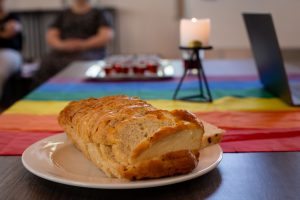The Bible and “Homosexuality”: An Invitation to Encounter, Risk, and Collective Curiosity

The biblical text is often used in contemporary African faith communities to condemn LGBTIQA+ people as an abomination before God and to label same-sex love as unnatural, un-Christian, and un-African. The recent passage of new anti-LGBTIQA+ laws in Uganda is but one example of how biblical interpretation informs values related to sexuality and gender in contemporary African communities.
In my experience spanning more than a decade as a Socially Engaged Biblical Scholar, journeying with faith communities in exploring issues of gender and sexuality, it has become clear that biblical narratives are often drawn upon in an anecdotal manner to claim God’s negative judgment of LGBTIQA+ people. Texts from the Bible are misused to condemn anyone who understands gender, desire, and love outside of traditional hetero-patriarchal binaries.
Within a hetero-patriarchal ideological frame, gender is understood in a biologically essentialist way. This view finds expression in a strict male vs. female binary which leaves no room for any diverse expression of biological sex, gender identity, and sexual orientation. Rather than functioning as a conversation starter, the Bible or Sacred Scriptures often function as a dead end to creative and imaginative explorations of the Scripturally-grounded contours of what it means to live in diverse communities. Because of this frequent use of the Bible as a conversation stopper, those seeking Scripturally-grounded inclusion may feel that turning to the Bible to reflect on LGBTIQA+ realities in a life-affirming way is counterintuitive for a number of reasons.
First, when listening to many African faith leaders, one often gets the impression that the Bible is clear on the issue of so-called “homosexuality.” African preachers, pastors, and prophets often draw on the so-called six-shooter texts to condemn LGBTIQA+ people as an abomination to God and nature (Gen 19:1-29; Lev 18:22, 20:13; Rom 1:18-32; 1 Cor 6:9 and 1 Tm 1:8-11). We hear this rhetoric so often, that it has become the dominant narrative.
For some, it might even seem that no alternative is possible. Within this paradigm, the Bible often functions as the last word, the definitive final proof of God’s judgment that ends all conversation and that informs the stigmatizing rhetoric often employed against LGBTIQA+ people in faith settings. It seems like no conversation is necessary, and that the final definitive interpretation has been reached.
In this context, turning to the Bible as a starting point for collective reflection on gender and sexual diversity often seems doomed for failure. Particularly since those sanctioned to engage the Bible seem certain of what it says and are not willing to have explorative discussions.
Second, considering the way that the Bible has been appropriated by Africans of faith to exclude and objectify LGBTIQA+ people and the trauma of such exclusion, it comes as no surprise that African LGBTIQA+ people often consider the Bible as something that belongs to the church or the academy and not to “us.” Rather than turning to the Bible as a source of liberation, it is viewed with suspicion and distrust.
In light of these perceptions, by both people of faith and LGBTIQA+ people, it is probably necessary to ask if the Bible can be a source of liberation for African LGBTIQA+ people. Could including the experiences of sexual and gender diversity make life-affirming interpretations of the Bible possible?
To my mind, a key to answering this question lies in the way faith communities draw on sacred scriptures to navigate life together and to distill the contours of a good life. Rather than an individual act reserved for the powerful and sanctioned, reading sacred scriptures within faith communities is a communal invitation to enter into a vulnerable encounter. This is an encounter not only with the biblical text—that is removed from us in time, context, and space—but also an encounter with others as we together embark on the journey of interpretation, devotion, and ethical reflection.
Reading the Bible together requires a sense of curiosity to explore the possible meanings of a text. It requires humility, teachability, commitment to community, and a willingness to change our minds and come to new conclusions together. It asks that we suspend our judgment and open ourselves up to the possibility of continuous reading and the outcomes of such exploration. It also challenges ideas about the ownership of the Bible as it challenges elite and individual “correct” readings of the Bible, opening up the possibility of new contextual and collective interpretations.
For those who have always had the privilege of Biblical ownership, either by religious school attendance, ordination, or divination, such new readings of the Bible require a self-critical stance as we reflect on our own positions of privilege. Reflection upon interpretative privilege urges us to move beyond the individual to the systemic as we reflect on the ways in which patriarchy has determined who gets to read the Bible with authority. It also highlights the harm that it has inflicted on those who embody diversity.
Persons who have never been able to read the Bible for themselves—or who have always been on the receiving end of judgment based on exclusivist interpretations of the Bible—might be suspicious of this invitation to read the Bible with others and might think that the Bible really has nothing to say to contemporary LGBTIQA+ people and faith communities.
Yet within Biblical narratives we find creative and dynamic possibilities. We encounter complex, contradicting narratives that serve as the starting point for rich conversations about difference, embodiment, power, and privilege. Biblical narratives, by their very nature, draw us into the dynamic process of interpretation and enable new imaginings as the lived and embodied realities of contemporary interpreters encounter the world depicted in the text. The Biblical text allows us to reflect on diversity when it comes to race, class, and ethnicity, and also, I would argue, when it comes to gender and sexuality.
When reading, for instance, the story of Joseph (Genesis 37-50) through a queer lens with fresh eyes we encounter someone who is clearly marked as different. Because of his dreams, his dress, and his non-conformist navigation of masculinity, Joseph’s difference is embodied and visible. This leaves him vulnerable and evokes a reaction from his brothers. We read how the brothers respond to this difference with hate and annihilating violence reminiscent of contemporary hate crimes.
In the unfolding of the narrative we also witness the complex process of forgiveness, reconciliation, and the restoration of broken familial relationships. Through collective readings, the story becomes an entry point for contemporary readers to talk about differences in the way people experience and present their bodies and the ways in which systems respond violently to keep norms intact. It also serves as a dynamic starting point to think about how we imagine alternative counter-communities of acceptance and care in the midst of diversity.
In the New Testament we find another example. In Acts 8: 26-40 we read of the Ethiopian eunuch and their encounter with the apostle Philip. The encounter is embedded in the complex and often trauma-filled narrative of the spreading of the Good News of the gospel and the development of the early Church. The episode shifts the focus in the book of Acts from the inclusion of familiar foreigners, the Samaritans, to unfamiliar foreigners, an Ethiopian eunuch. Here, a gender-diverse character becomes the bearer of the Good News and an example of the inclusive community that the church of Christ is to become. The text enables contemporary communities to reflect on their own perceptions and understandings of those who are gender diverse and on the Good News that the gospel holds for those whose sexuality and gender are outside the hetero-patriarchal norm.
So my work, and that of many allies and friends, invites us not to be limited to the six classic anti-homosexuality texts when engaging issues of sexual diversity. The Bible holds a rich array of narratives that could guide us into more authentic and complex conversations about difference and sexuality if we are willing to accept the invitation to collective vulnerability and curiosity.
#
Charlene van der Walt has until recently served as the head of the Gender and Religion Unit at the School of Religion, Philosophy, and Classics at the University of KwaZulu-Natal in South Africa and as the deputy director of the Ujamaa Center for Biblical and Theological Community Development and Research. Although Charlene remains connected to the University of KwaZulu-Natal as a senior research associate, she has recently joined the Church of Sweden as the global coordinator for theological education. Charlene’s primary research interests include queer theory/theology, queer biblical hermeneutics, contextual Bible study, and emerging- experimental pedagogies in the study of religion and theology. Charlene can be contacted at: [email protected]
Counterpoint blogs may be reprinted with the following acknowledgement: “This article was published by Counterpoint: Navigating Knowledge on 12 April 2023.” The views and opinions expressed on this website, in its publications, and in comments made in response to the site and publications are those of the author(s) and do not necessarily reflect the views and opinions of Counterpoint: Navigating Knowledge, its founders, its staff, or any agent or institution affiliated with it, nor those of the institution(s) with which the author is affiliated. Counterpoint exists to promote vigorous debate within and across knowledge systems and therefore publishes a wide variety of views and opinions in the interests of open conversation and dialogue.
Photo credit: http://www.instagram.com/alexasedge or @AlexaSedge



